An in-depth investigation is currently ongoing to establish the extent of black fly breeding sites or sources within the La Nkwantanang-Madina Municipality and Dawhenya in the Greater Accra Region.
The effort at La Nkwantanang is being spearheaded by the Environmental Health and Sanitation Unit of the municipal assembly to enable the government and its agencies to fight the invasion of harmful insects head-on in parts of the municipality.
This is after entomological and epidemiological investigations by the Noguchi Memorial Institute for Medical Research (NMIMR) confirmed the presence of the black fly larvae in the Dakubi Stream, a fast-flowing water body from the Akuapem Ridge lying between Oyarifa-Teiman and Abokobi that runs into the Odaw River.
Although the Dakubi Stream has been confirmed as a breeding source, authorities at the municipal assembly believe that there may be other streams and rivers responsible, and, therefore, requires thorough scouting of the municipality.
Some of the affected communities are Kponkpo, Borga Town, Teiman, Oyarifa, Abokobi, Ayi Mensah, Danfa, Peduasi and Adenta.
The Member of Parliament (MP) for Ningo-Prampram, Sam Nartey George, in a statement issued last Monday, said he had received a complaint “of a suspected invasion of black flies in the Dawhenya Electoral Area and extending to some parts of the Laluekpo Electoral Area”.
The statement said his office “is working closely with the District Health Directorate and the District Environmental Health and Safety Directorate to ensure that once we have an identification of the fly species and a protocol for containment established, we can work swiftly in the interest of my constituents”.
Black flies characteristics
Black flies, sometimes called buffalo gnats, are harmful insects that have a resemblance to a mosquito ranging in sizes from five to 15 millimetres, dark and relatively robust, with an arched thoracic region.
They have large compound eyes, short antennae, and a pair of large, fan-shaped wings.
The adult black flies bite mammals (humans, livestock and pests) to feed on blood.
With the ability to fly up to 20 miles and more to cause havoc, the insects are responsible for the transmission of river blindness or onchocerciasis when victims are exposed to their bites between one and two years.
The disease is called river blindness because the black flies that transmit the infection live and breed near fast-flowing streams and rivers.
In Ghana, these insects are often found in some parts of the Northern and Eastern regions, but in recent times parts of the Greater Accra Region have started experiencing an upsurge in their invasion.
Precaution
The black flies are attracted to dark-coloured clothing, sweat on the skin and sweet-smelling scents.
Their bites are painful, itchy and can cause severe allergic reactions.
There is no need to worry about them when indoors, as they are only active during the day.
Daily Graphic visit
When the Daily Graphic team visited the stream and some of the affected communities last Tuesday, residents said they were going about their daily routine cautiously, and confirmed that they had noticed an invasion of the insects in the last two months.
A resident, who gave his name as John Adams, said: “We have heard that these flies can cause blindness. Our fear is that it may infect our children”.
A municipal assembly pickup with a public address (PA) system moved about at Danfa, creating awareness and educating the public about the insects.
Beyond the Dakubi Stream, the residents also pointed to two more streams believed to be the breeding sites of the flies in Danfa and Ayi Mensah.
Within these neighbourhoods, residents dressed to cover almost all parts of the body, wearing socks and gloves in some cases.
Assembly confirmation
The Head of the Environmental Health and Sanitation Unit (EHSU) of the municipal assembly, Joseph Quarcoe, confirmed to the Daily Graphic the presence of the black flies in the municipality.
“As soon as the EHSU received the information of the strange insect invasion on July 13, this year, we arranged with the Disease Control Unit of the assembly to conduct initial investigations, which included site visits and collecting samples from the stream for entomological investigation at the NMIMR.
“Officials of NMIMR subsequently visited the site to collect different samples which later established that the Dakubi Stream is the breeding source of the flies,” he said.
Scouting
Mr Quarcoe said the assembly was scouting the municipality to identify the fast-flowing streams and rivers to apply larvicide that could destroy their larvae to prevent them from metamorphosing.
The head of EHSU said the good news was that the adult black fly could live between 15 and 30 days and, therefore, disinfecting them might not be an appropriate solution because their larvae would still bring them back in their numbers.
He said the assembly was engaged in public education on precautionary measures, larviciding and clearing the weeds and bushes along the stream to stop the invasion and eradicate the larvae from the municipality.
Mr Quarcoe said so far no one had been infected with any disease because an individual needed to expose himself or herself for a period of one to two years before the river blindness disease would manifest.
ALSO READ:

